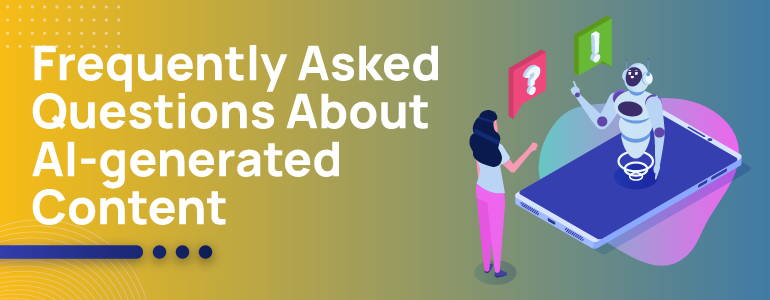Frequently Asked Questions about AI-generated Content
Here are some of the Frequently Asked Questions about AI – generated content
What is AI-generated content?
AI-generated content is a game changer in the field of artificial intelligence. It uses advanced language models, such as GPT-3, thoroughly trained on massive datasets, including various textual content. This training provides the language models with a comprehensive understanding of grammar, context, and language patterns, allowing them to produce coherent and contextually appropriate content.
Users supply input cues or directions to the language model while creating AI content. The model then processes the input and output text that closely mimics human-written content in tone, style, and overall structure.
AI-generated material has a wide range of applications. It can be used to create content for blogs, articles, product descriptions, social media posts, and other purposes. Furthermore, AI-generated responses in customer support contacts, chatbots, and personalized communications are becoming more common in various businesses. Overall, AI-generated content is a potent tool that augments human creativity and efficiency, opening up new avenues for content creation and communication.
However, while AI-generated content improves efficiency and productivity, it raises ethical concerns. Maintaining credibility and openness with users and readers requires ensuring accuracy, avoiding misinformation, and correctly attributing AI-generated material.
Is AI-generated content reliable?
The dependability of AI-generated content is determined by the underlying AI model’s resilience and the training data’s quality. AI models like GPT-3 have demonstrated outstanding ability in producing coherent and contextually relevant content that closely resembles human writing. They are, nevertheless, susceptible to errors or biases in the training data.
AI-generated content may produce false or misleading information when presented with confusing input prompts or insufficient training data. As a result, it is necessary to perform a thorough assessment and fact-checking before publishing or relying on AI-generated content for critical topics.
To improve trustworthiness, several businesses employ AI-generated material as a starting point for human authors to edit and validate the information. This collaborative approach maintains a balance between the efficiency of AI-generated content and the accuracy and competence of human writers.
While AI-generated content has enormous promise for content generation, it requires careful management and validation to preserve its trustworthiness and credibility in delivering accurate and trustworthy information.
Can AI-generated content replace human writers?
While AI-generated content has revolutionized the writing landscape, it cannot entirely replace human writers. AI is adept at producing coherent and contextually relevant text based on patterns in vast datasets. It is valuable for automating routine writing tasks, generating product descriptions, or even basic news reports.
However, human writers possess unique qualities that AI cannot replicate. Creative writing, storytelling, and crafting emotionally engaging content require the human touch of creativity and empathy. Human writers can infuse their work with emotions, humor, and personality, resonating with readers on a deeper level.
Furthermore, human writers excel in understanding complex nuances and adapting content to specific audiences and cultural contexts. They can conduct in-depth research, analyze diverse perspectives, and deliver original and thought-provoking insights.
In summary, while AI-generated content is a valuable tool for efficiency and productivity, it cannot replace human writers’ creative and empathetic capabilities. A harmonious integration of AI assistance and human ingenuity will continue to be the winning formula in the dynamic world of content creation.
What are the potential use cases for AI-generated content?
The potential use cases for AI-generated content are diverse and span various industries. In content creation, AI can be a game-changer, assisting writers in generating articles, blog posts, and product descriptions faster. Automating routine writing tasks frees up human writers to focus on more creative and strategic aspects of content development.
AI-generated content also plays a vital role in customer support. Chatbots powered by AI can provide quick and accurate responses to customer queries, improving response times and enhancing customer satisfaction. These chatbots can handle repetitive inquiries, freeing human agents to address more complex issues.
Personalization is another area where AI excels. By analyzing user behavior and preferences, AI can create tailored content recommendations and personalized marketing messages, enriching the user experience and fostering customer loyalty.
Data analysis is yet another valuable application. AI can process vast amounts of data, identifying patterns and insights that would be challenging for humans to uncover. This helps businesses make data-driven decisions and optimize their strategies.
Overall, AI-generated content has the potential to transform numerous industries, streamlining processes, enhancing customer experiences, and unleashing new opportunities for growth and efficiency.
Are there any ethical concerns regarding AI-generated content?
Indeed, AI-generated content raises significant ethical concerns that warrant careful consideration. One pressing concern is the potential for misuse to spread misinformation. While proficient at generating text, AI models cannot verify the accuracy of the information they produce. This can lead to dissemination of false or misleading content, potentially harming individuals or causing public confusion.
Plagiarism is another ethical concern. AI can inadvertently produce text that resembles existing copyrighted material, raising questions about intellectual property rights and originality. Striking a balance between AI-generated content and respecting existing content creators’ work is essential.
Transparency is paramount in ethical AI-generated content. Readers have the right to know if the content they consume is generated by AI. Disclosing this fact promotes trust and allows readers to interpret the content with appropriate context.
To address these concerns, guidelines and best practices for responsible AI use are vital. Educating content creators about the ethical implications of AI-generated content and encouraging thoughtful, critical reviews of AI-generated text can help mitigate potential risks.
In conclusion, while AI-generated content offers incredible potential for efficiency and productivity, ethical considerations must guide its responsible use. By adopting proper guidelines and promoting transparency, businesses can harness the power of AI while upholding ethical standards and ensuring the integrity of the information provided to readers.

